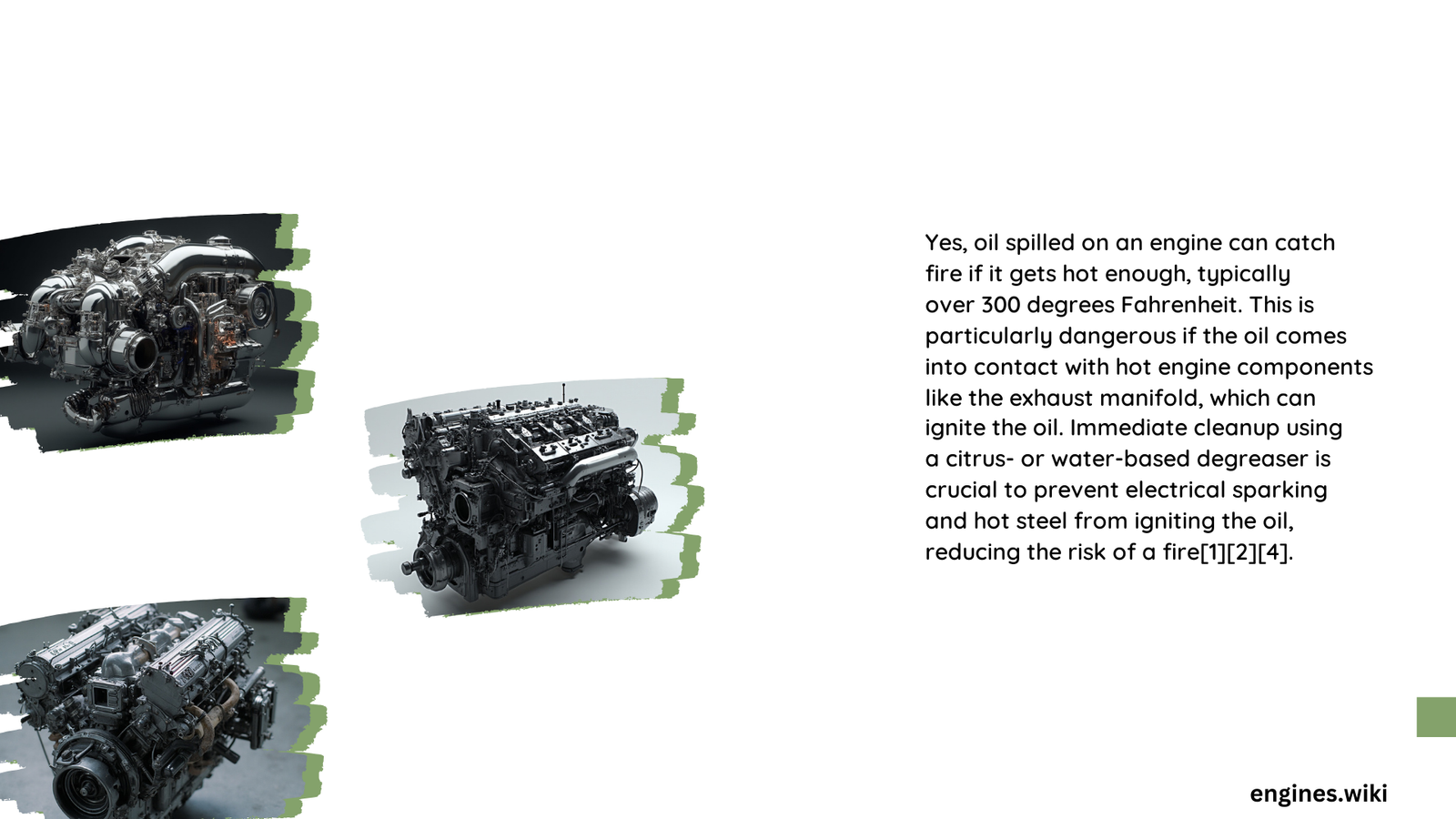Oil spilled on an engine can potentially catch fire, but it depends on various factors such as the type of oil, engine temperature, and the location of the spill. The risk of ignition increases when oil comes into contact with hot engine components or exhaust systems. While not all oil spills result in fires, it’s crucial to address leaks promptly and maintain proper engine care to minimize the risk of fire hazards.
What Are the Ignition Temperatures for Different Types of Engine Oil?
Understanding the ignition temperatures of different engine oils is crucial in assessing the risk of fire. Here’s a breakdown of the auto-ignition temperatures for various types of engine oil:
- Conventional Engine Oil:
- Heated crucible tests: 580°F to 635°F (304°C to 335°C)
-
Full-scale vehicle tests: 760°F to 870°F (404°C to 466°C)
- Heated crucible tests: 590°F to 680°F (309°C to 360°C)
-
Full-scale vehicle tests: 590°F to 790°F (309°C to 421°C)
-
General Flashpoint:
- Traditional motor oil: 300°F to 400°F (149°C to 204°C)
- Synthetic motor oils: 450°F to 700°F (232°C to 371°C)
It’s important to note that synthetic oils generally have higher flashpoints and auto-ignition temperatures, making them less prone to ignition compared to conventional oils.
Which Engine Components Are Most Susceptible to Oil Leaks?

Several engine components are particularly vulnerable to oil leaks, which can increase the risk of fire if the oil comes into contact with hot surfaces. Here are the main areas of concern:
- Engine Gaskets and Seals
- Oil Pan and Drain Plug
- Valve Cover Gaskets
These components require regular inspection and maintenance to prevent oil leaks and reduce the risk of fire.
How Can Engine Fires Due to Oil Spills Be Prevented?
Preventing engine fires caused by oil spills involves a combination of proper maintenance, careful handling, and prompt action. Here are some best practices to follow:
- Regular Maintenance:
- Inspect gaskets and seals regularly
- Replace worn components promptly
-
Follow manufacturer-recommended service intervals
-
Use of Synthetic Oil:
-
Consider switching to synthetic oil for its higher flashpoint and auto-ignition temperature
-
Proper Cleanup:
- Use oil spill absorbents to clean up any spills immediately
-
Keep engine compartment clean and free of oil residue
-
Avoid Driving with Leaks:
- If you detect an oil leak, do not drive the vehicle
-
Have the vehicle inspected and repaired by a qualified mechanic
-
Monitor Engine Temperature:
- Keep an eye on your vehicle’s temperature gauge
- Address any overheating issues promptly
What Are the Signs of an Oil Leak in Your Engine?
Detecting oil leaks early can help prevent potential fire hazards. Look out for these signs:
- Oil spots or puddles under your parked vehicle
- Burning oil smell while driving
- Blue smoke from the exhaust
- Low oil level on the dipstick
- Oil warning light on the dashboard
- Engine overheating
If you notice any of these signs, it’s crucial to have your vehicle inspected by a professional mechanic as soon as possible.
How Does Engine Temperature Affect the Risk of Oil Ignition?
Engine temperature plays a significant role in the risk of oil ignition. Here’s how temperature impacts the likelihood of an oil fire:
- Normal Operating Temperature:
- Most engines operate between 195°F to 220°F (90°C to 104°C)
-
At these temperatures, oil is unlikely to ignite
-
Overheating Conditions:
- Engines can reach temperatures above 230°F (110°C) when overheating
-
As temperature increases, the risk of oil ignition also rises
-
Hot Spots:
- Certain engine components, like the exhaust manifold, can reach much higher temperatures
-
Oil spilled on these hot spots is at greater risk of ignition
-
Temperature vs. Flashpoint:
- If engine temperature exceeds the oil’s flashpoint, the risk of fire increases significantly
- Synthetic oils with higher flashpoints provide a greater safety margin
What Should You Do If You Notice an Oil Spill on Your Engine?
If you discover an oil spill on your engine, take the following steps to minimize the risk of fire:
- Turn off the engine immediately
- Allow the engine to cool down completely
- Identify the source of the leak
- Clean up the spilled oil using appropriate absorbents
- Inspect for any damage to hoses, gaskets, or seals
- Have the vehicle inspected by a professional mechanic
- Do not drive the vehicle until the leak is repaired
Are There Any Long-term Effects of Oil Spills on Engine Components?
While the immediate concern with oil spills is the risk of fire, there can also be long-term effects on engine components:
- Rubber Deterioration:
- Oil can cause rubber hoses and seals to degrade over time
-
This can lead to further leaks and potential engine damage
-
Electrical Issues:
- Oil can interfere with electrical connections and sensors
-
This may cause erratic engine performance or warning lights
-
Catalytic Converter Damage:
- Oil entering the exhaust system can damage the catalytic converter
-
This can lead to reduced fuel efficiency and increased emissions
-
Engine Overheating:
- Persistent oil leaks can lead to low oil levels
-
This may cause increased friction and engine overheating
-
Reduced Engine Lifespan:
- Continuous exposure to oil leaks can accelerate wear on engine components
- This may result in a shorter overall engine lifespan
To prevent these long-term effects, it’s crucial to address oil leaks promptly and maintain proper engine care.
In conclusion, while oil spilled on an engine can potentially catch fire, the risk depends on various factors such as oil type, engine temperature, and the location of the spill. By understanding these risks, practicing proper maintenance, and addressing leaks promptly, you can significantly reduce the chances of an engine fire and ensure the longevity of your vehicle’s engine.
